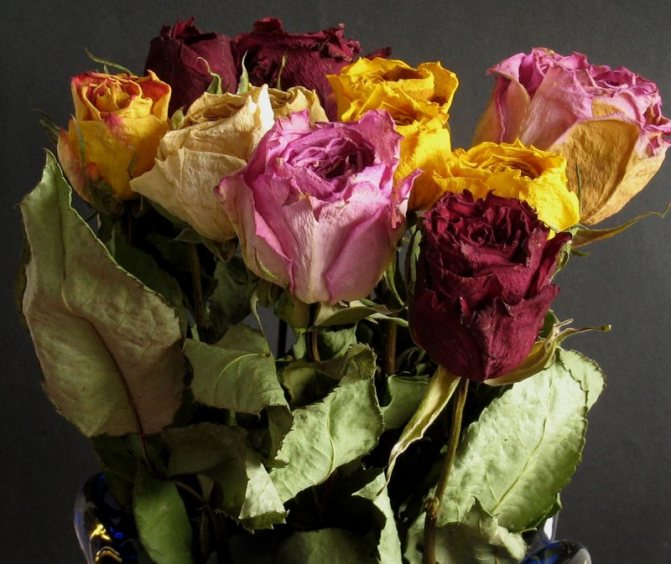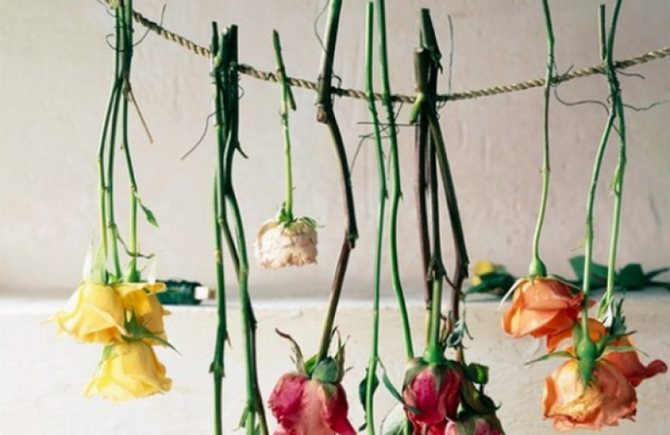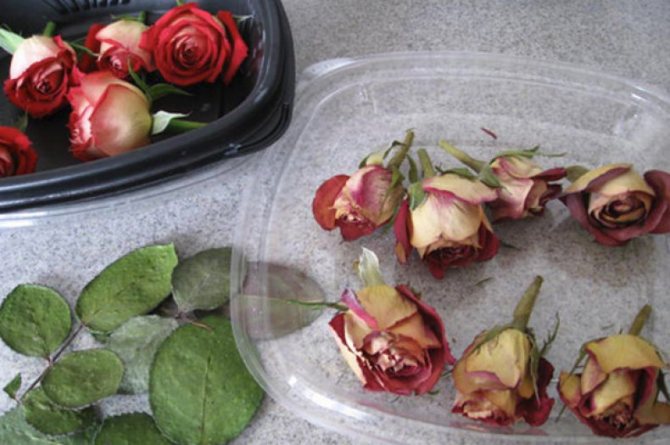Most women prefer a rose to all colors. And therefore it is doubly a pity to throw them away after the flowers wither. And why do this if you can dry the roses and thereby extend their life, but in a different form ?! After all, a lot of different compositions for decoration are made from dry plants, ranging from simple dried bouquets to complex paintings. A simple method of drying flowers (as for a herbarium) is not very suitable here. Roses must be dried so that they do not lose their shape.

How to dry a bouquet of roses at home? Air drying
A simple and affordable way to dry a bouquet of roses or a whole flower. Its disadvantage is that the color of the flower may change (darken or lighten).
Drying requires a dark (the main thing is that there is no direct sunlight) and dry room with good ventilation (darkened loggia or balcony, veranda, pantry, attic, attic).
- Pull a clothesline (fishing line, wire) in the room, but no closer than 15 cm to the ceiling. If there are few roses, then you can drive in a long nail or find a hook.
- Cut 1-3 pairs of lower leaves, depending on the length of the flower, to make it look aesthetically pleasing, shorten the stem a little and remove all thorns. Wrap each rose individually with twine (elastic, strip of fabric).
- Tie it to a rope, attach it with a clothespin, or hang it by a hook (open paperclip). The distance between flowers is at least 5-10 cm, otherwise they may dry out or rot in an ugly way.
- Drying usually lasts 14-20 days. At this time, check with a toothpick how dry the flowers are. A dried flower has petals that are hard and fragile to the touch.
Rules and Tips
- If ventilation is poor, ventilate the room at least twice a day.
- Be sure to cover the flowers with gauze so that dust does not settle on them. If it appears on the petals, then after drying, the dust is almost impossible to remove without breaking them.
- From dried flowers, you can collect a new bouquet of roses and decorate your house with them.
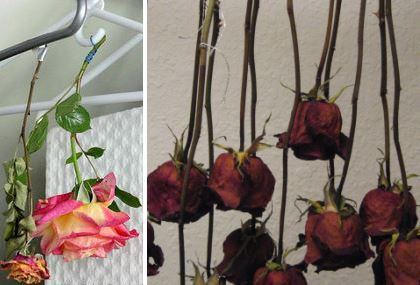

Hanging roses to dry
How to dry a whole rose with cotton wool?
The same drying method as the previous one, the petals keep their shape well.
- Move all the petals (even the most central ones) with pieces of cotton wool so that they do not touch each other.
- Then hang the rose by the stem to dry on a rope in a dark and dry room. The bud dries up in about 5-7 days, but remove the cotton wool carefully with tweezers only after the stem is completely dry.
Useful Tips
Experienced florists who dry roses give the following recommendations:
- Any dried rose changes color, but to varying degrees. It also fades when used in floral arrangements. To preserve the beauty of the buds, they can be tinted with regular nail polish.
- To keep the dried rose in shape better, you can fix it with hairspray. But you need to spray it carefully: the product should not wet, it should cover the petals.
- Store dried buds and petals in a cool and dark place. They can be put in a tin container. Storage in a glass container with a lid in the refrigerator is allowed.
Dried roses are graceful in their own way. Unlike fresh cut flowers, they can decorate the interior for many months and even years.Dry half-open buds or individual petals to create a unique painting or unusual mural. And from unclaimed flowers, prepare a fragrant and tonic tea.
Flowers are striking in their beauty and shape. I want to keep their charm as long as possible. But, sooner or later, the plants begin to wither and lose their beautiful appearance. And at such moments, many ask the question: how to dry roses so that they do not lose their color and shape, because they are most often given to loved ones.
In order not to lose the appearance of beautiful buds, we will tell you about some rules for drying flowers. Having learned about them, you will forever preserve the plants in their original form.


How to dry a rose in a book and under pressure?
An easy and simple method that can dry the bud or rose petals. It is better to put the flower not immediately in a book, but in rice napkins or office paper for printing A5 or A4 (fold the sheet in half and cut).
- In a folded sheet of paper, put a bud with a 1-2 cm part of the stem, straighten the petals and carefully close the "envelope". Then wrap with rice napkins or another sheet of paper.
- Write on the sheet the date of the beginning of drying, put the "envelope" in the book and press it down with a small weight (a stack of books, a pack of salt, flour, sugar or cereal).
- Change tissues and paper every 1 to 2 days for the first two weeks to absorb moisture. Usually a rose is dried in a book for 30-40 days.
Rules and Tips
- It is preferable to dry the flower in a book with yellow paper, it absorbs moisture better than white dense and glossy. As a rule, these are old books or new inexpensive editions.
- Remember that the bud will become flat (can be used for a panel, painting, floral collage or postcard).
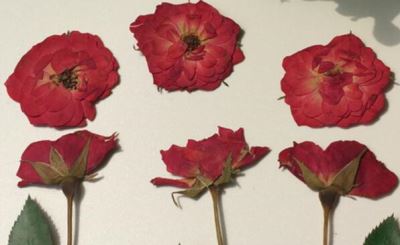

Dried rosebuds in a book
Press drying
The method is great for drying a rosebud or petals to create a panel or painting. You can use a special press for drying plants, or you can do it yourself or press it with glass.
- Place the bud with 1 to 2 cm of the stem on cardboard (plywood, board) lined with 4-5 sheets of paper or rice napkins.
- Cover the flower with 4-5 sheets of paper, and then with thick cardboard and evenly place the load (bags of cereals, sugar, salt, flour, or a stack of books). It turns out such a "layer cake": cardboard - paper - rose - paper - cardboard - cargo.
- Change the paper every 1 to 2 days to speed up the drying process and prevent excess moisture from rotting. On average, a rose dries up in 20-30 days.
- After removing the load, it is better to place the flower for 3-4 days on a 2-3 cm layer of semolina or calcined sand in a box, and sprinkle them a little on top.
How to keep flowers
Another traditional method is water drying. It sounds very contradictory, but this method allows you to easily maintain the shape and color of the plant. It is great for flowers with a sturdy stem and for those in which you want to keep that stem.
In order for the process to be successful, you need some kind of vessel, deep plate or container. Pour the minimum amount of water on the bottom and place your flower there. Over time, the water will begin to evaporate, and the flowers will dry without much stress on them, retaining their color and shape. This may take about 1-2 weeks.
Drying in the oven
In order to dry flowers in the oven, the temperature must be low - no more than 38 º C, otherwise they will simply burn out and lose their beauty. People have been using this method ever since the ovens were invented, because it is very convenient and does not require additional costs.
It's great because it will save you if your home doesn't have a place to air dry, or if you need to dry something in a short time. You can also resort to it for a kind of safety net.If you are not sure that when air-drying or in water, all the moisture has left the flower, and it will not become moldy, place it in the oven - this gives one hundred percent result.
To do this, you need to set the temperature in the oven to 38 º C, and slightly open the door so that excess moisture can escape freely. Place the flowers or petals in a single layer on baking paper and place the baking sheet in the oven.
Watch the process and turn the flowers every 15 minutes. When the flowers are brittle and crunchy, remove them from the oven and the decoration is done. Depending on what you are drying, the process can take anywhere from a few minutes to several hours, so try not to dry several different types at the same time.
How to dry a rose in various substances? Bulk drying
In this way, you can dry the whole flower or just the bud. The advantage of the method lies in the maximum preservation of its appearance. As a rule, the shape and color of the bud are perfectly preserved: the petals do not wrinkle or fade.
- Cut a flower with a 2-3 cm part of the stem and insert a wire into it perpendicularly, and roll the rest into a ring.
- Fill a deep container (box, bowl, jar, cup, etc.) with a 4-5 cm layer of a loose substance that absorbs moisture well, and place the bud with the base down on top. If you want to dry the whole rose, then pick up a long box and put it in it strictly horizontally.
- Sprinkle the petals delicately so that there is a layer of desiccant between them, so that it can get as close to the middle of the flower as possible. After the substance has completely covered the petals, close the container with a lid and transfer it to a dry and warm place without direct sunlight. If the container is open (for example, a box of sand), then this place should be well ventilated.
- After 4-5 days, check the dryness of the bud with a toothpick. If the edges of the petals become dry and hard to the touch (the flower looks like paper - strong, but not brittle), then remove it with tweezers. Depending on the choice of dehumidifier, the drying time of the rose varies: silica gel - 5-7 days, flour, semolina, borax - 14-18 days, sand - 15-25 days.
- Gently shake off any remaining desiccant with a brush or blow out with a blower. Wire the rosebud to the stem. The stem is air dried separately (description at the top of the page).
How to choose a desiccant (desiccant)?
The most popular substances with good absorbing properties are: white flour, borax (sodium tetraborate), corn, semolina and oatmeal, perlite, silica gel (silicate gel), talc.
- White flour or corn grits and borax... Substances readily available, but borax is easier to find in a big city. Drying time is 14-18 days. You can dry in each substance separately, or you can make a mixture: corn grits and borax - 1: 1, or flour and borax - 4: 1.
- Semolina. A proven and affordable product. After semolina, the rosebud is cleaner than after sand.
- River sand. Before use, the sand must be sieved and must be calcined for disinfection in the oven. Using sand, it is better to dry the rose in a cardboard round box, at the bottom of which it is then easy to make holes, since it is easier to remove it from the bottom. The bud does not need to be covered completely, as the sand is needed for fixing, and the petals will dry from the air in a dry and dark room with excellent ventilation. Such drying lasts - 15-25 days.
- Silica gel... Advantages: high drying speed, reusability. Disadvantage: rather high price, depending on the company, 2-4 dollars for five liters of substance (litter for cats in a pet store). The finer the silica gel, the better (you can grind it yourself). It is better to fill it up in a container that closes tightly (jar, container). Silica gel turns pink after moisture absorption.To evaporate moisture from it, pour it onto a baking sheet and put in the oven for 2-3 hours at a temperature of 90-100 ºC.


Drying rose in silica gel
Flowers as a gift
Drying with silica gel
This method is ideal for drying large, whole flowers. Initially, salt and sand were used for traditional drying. However, these materials are more difficult to clean, the process takes 6 to 8 weeks, and the result is always unpredictable.
Nowadays, instead of sand and salt, silica gel is used - transparent or white crystals, sometimes with blue blotches. It allows you to dry the flower in a few days, keeping its original color and shape as much as possible. Often times, plants dried with silica gel look almost the same as freshly harvested ones.
The silica gel absorbs the liquid from the plant, and the blue crystals turn pink, signaling that the maximum possible amount of liquid has come out of it. The process must take place in an airtight container.
In addition, silica gel can be reused - for this it only needs to be thoroughly dried. To do this, the used crystals must be placed on a baking sheet and sent to the oven preheated to 210 degrees Celsius. When the crystals turn blue again, they can be reused.
How to dry roses quickly?
If you need to quickly dry a flower, you can use a microwave oven. Be careful, as there is a risk of overdrying it (the appearance will deteriorate and become too brittle). Therefore, you need to have several copies in stock in order to get the desired result.
- Put an incompletely opened bud with a 2-3 cm part of the stem in a closed container with a desiccant (semolina, sand, silica gel, etc.) and put it in the microwave.
- Turn the microwave on for two minutes on medium power. Check how dry the bud is with a toothpick. Turn on the appliance for one minute until the flower is completely dry (the petals are strong, but not brittle or crunchy, as if made of paper). It usually takes 4-7 minutes.
- Remove the container from the microwave, open it and refrigerate for 12-36 hours, depending on the desiccant.
Advice
- Can be dried without a desiccant. To do this, place a cup of water next to the flower on a saucer to reduce the color fading of the flower and prevent excessive drying.
- In order not to dry out the flower, after the first 2-3 minutes of drying in the microwave, you can take it out and put it on drying in a dehydrator (instructions above in the article) or hang it on a rope for 2-3 days (air method, instructions above in the article).
- For a more delicate drying, you can try the defrost mode, which is better for flowers with delicate and fragile petals.
DIY herbarium
Air dry
Air drying is one of the easiest and least costly ways to keep flowers as close to their original shape as possible. This does not require special devices, apparatus or substances.
You just need to cut the flower you want to dry if it grows in your garden, or cut the stem to the length you need if it is in a vase on your table. Remove thorns and leaves from the bottom of the stem, tie the twigs into one bunch so that the buds do not deteriorate or deform. Hang the bouquet in a well-ventilated area, away from sunlight, otherwise the flowers will simply fade.
The whole process can take from a few days, so be patient and the result will amaze you. However, it is worth remembering that the flower will lose in ode and become approximately two times smaller, as well as lose its original light. Don't be discouraged, though - their vintage look will give your piece a spice.
Dry in the microwave
Drying flowers in the microwave is currently the newest, fastest and most effective way.One of its main advantages is that the color and shape of the flower does not practically change. It retains its former beauty. However, it is worth remembering that this method is not suitable for small delicate flowers.
To dry a flower in the microwave, you will need either a small amount of silica gel or cat litter crystals. Place the silica gel or crystals in a microwave safe dish. Make a small notch in them with your finger, put a bud in it and fill it with crystals as carefully as possible.
Then turn on the microwave for 1-2 minutes. Check the flower every 30 seconds until it is completely dry. Leave the flower and crystals to cool. Remove the flower carefully from the crystals and enjoy the result. Most flowers dry out within 1-3 minutes. Remember that the juicier the petals, the more time they need.
How to dry a rosebud at home?
We described the methods for drying the buds above, but here we will deal with the goals and give recommendations.
- If you want to preserve the shape of the flower and the color of the petals, then use the volumetric drying of the flower in a desiccant (a substance that absorbs moisture well).
- If the shape is not important or you need a flat one (creating paintings, collages, panels, etc.), then you can dry the rosebud in a book or under a press.
- If you need the flower to dry quickly, then a microwave oven will come to the rescue.
Air-dried rosebud option from an experienced florist
- Cut the flower with a 2–3 cm “stem” when it starts to bloom.
- Hold it for 10-20 seconds over boiling water.
- Then stick a needle with a long thread into the stem and hang it in a dry and ventilated room (you can even on a chandelier in a darkened room). It is very important that it is not dusty or wrap the flower with gauze.
- After 4-6 days, the bud dries up, it turns out beautiful and even.
Secrets and recommendations from experienced florists and florists
Not many people know that after drying, each rose loses its rich shade, in addition, the plant in the compositions quickly burns out. To brighten up the buds, you can simply paint them with nail polish. And in order for the bud to keep its shape well and for a long time, it should be covered with hairspray, but it is impossible for the agent to wet the workpiece, a light spray is enough. Prepared buds should be placed in a container, and then removed to a dark place where it will be cool. Storage in the refrigerator compartment is also possible.
If you prepare roses correctly, compositions of dried flowers will delight the eye for several years. From individual petals, you can create unusual crafts or unique paintings for the interior.
You don't want to part with beautiful, attractive and fragrant roses, so they are often dried. What to do with dry buds and petals, how to use them? We will tell you about this and how to dry roses at home, what varieties of plants are used for this purpose on our page.
How to properly dry rose petals at home?
Some methods are suitable for the petals, which are also used for drying the buds or the whole flower.
Natural drying
- After you have dried the flower (instructions above in the article), you need to separate the petals.
- You can immediately pick the petals, spread them on paper and cover with gauze on top. There should be a distance between the petals.
- Turn them over every 5-7 days to dry evenly. After 12-18 days, the rose petals will dry out, become crisp and firm, like cornflakes, and will be suitable for further use.
In the book and under the press
It is convenient to dry the petals in a book, the technology is exactly the same (described above in the article), only you first need to separate them from the bud.
Drying in a dehumidifier
You need to dry the whole rose bud (the method is described above), and then separate the petals.
Microwave
- Cover a plate (heat-resistant) with a paper towel or napkin. Arrange the petals in one layer and without contact between them. Cover them gently with a napkin (paper towel) and place a plate on top.
- Place the plates in the microwave and turn on high power for 40-60 seconds. Since the devices differ in power, it is necessary to start with a minimum period of time in order to experimentally establish the optimal drying time.
- Check how dry the petals are. Repeat the sessions until the petals are dry to the touch, but without crunching.
- After dry enough, remove the petals. If you want crispy ones, spread them out on paper in a dark, dry place, and cover with cheesecloth on top.
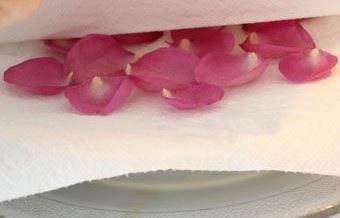

Microwave drying rose petals
Oven
- Line a baking sheet with paper (baking parchment) and arrange the petals in one layer.
- Place the baking sheet in the oven for 15 minutes, and then turn the petals over and set, again for 15 minutes at a temperature of 60-80 degrees.
- The oven door must be ajar during drying.
Dry flowers
A way for the lazy
For especially lazy beauty lovers, there is a way to dry flowers that does not require much effort. Hydrangea, for example, is ideal for this purpose. Cut the stem of the hydrangea with the bud as long as needed. It is worth cutting off when the petals feel like paper.
Place the stems in a vase with a little water and wait for the water to evaporate. At first it may seem that the flower is losing its original beauty, but do not forget that it dries up, and it is normal that it changes shape and color. Use them as a decoration a few weeks later, or just leave them standing in a vase.
Dry under the press
It must be warned that this method is not suitable for drying flowers with bulky buds, if you want to keep their shape - they will simply become flat. Chamomiles, dandelions, carnations and other flowers that do not deform much under pressure are ideal choices, but the final decision is yours.
In order to press dry and preserve their beauty, harvest healthy plants without blemishes or damage. It is best to cut them on a sunny day, if there has been no rain for some time before, so that no drops of water or dew remain on the petals.
Cover the flower with parchment or baking paper and place it face down in a thick, heavy book. It is desirable that this be a telephone directory. After that, leave the flower under pressure for 7-10 days, sometimes checking the result if desired.
What can be made from dried roses, buds and petals?
Interior decoration. For example, a bouquet of dried roses in a beautiful vase or basket will decorate an inconspicuous corner of your home and will cheer you up on long winter evenings. Especially if it is a bouquet from a loved one, presented on a pleasant occasion.
In fact, ideas for decorating a room largely depend on the existing interior and imagination. Dried roses are widely used for theme parties or celebrations (for example, New Year's Eve).
How to use dried rosebuds?
- Dried flowers can be used to create various floral collages, appliques, herbariums, garlands, paintings and panels. To make a panel or picture, you need to dry the rosebuds with a flat drying (book, press).
- Creation of jewelry. With the help of rosebuds and petals, you can make earrings, a ring, a pendant or a button. Experts fill them with a special epoxy resin (for example, "Crystal Resin") and make unique handmade jewelry.


Paintings of dried roses
What can be made from dried rose petals?
- Floristic compositions and decorations. Like buds, rose petals can be used to create collages, appliques, paintings and panels, or bookmarks for a book. You can make a unique petal necklace or bracelet.
- Cosmetics and perfumery. You can prepare a homemade cream, facial lotion, or an exclusive pink perfume. The pleasant scent of a rose will cheer you up even in the gloomiest weather outside the window.
- Entourage. Rose petals are often an integral part of a wedding ceremony or romantic date. When they, like confetti, are sprinkled on newlyweds, decorate the bedroom and bed, or take a bath or jacuzzi with them.
- Cooking. You can make delicious jam, cake addition, or sandwich filling. The petals can be added to your favorite drinks: milkshake, alcohol (martini, vodka, tinctures). You can also make tonic rose water. Tea Recipe: Mix dried rose petals with a little green or black tea to your liking. Pour boiling water over and leave for 6-8 minutes. Candied petals. Each petal must be separately moistened in sugar syrup (caramelization). Quite a painstaking task, but candied fruits melt in your mouth pleasantly.
About herbarium of roses
In history, references to herbariums are romantic in nature. Lovers kept flowers as a sign of love for a person or just in memory of him. Later, the herbarium began to be studied in science, and today dried roses are used to decorate rooms, to create unusual crafts and decor details.
Previously, you could get a bright dried flower only with the help of a book. The bud was placed between the pages and left there for some time until it dries completely. Today, herbariums are created using other methods that help to preserve not only the bright color of the buds, but also the volume. A rose herbarium perfectly complements a bedroom or bathroom.
Dried flower paintings
Oshibana is the eastern direction of floristry, in which paintings are created from dried plants. By properly preparing your wilting rose bouquet, you can practice this art.


You can dry both whole buds and individual petals and leaves, it depends on what kind of fantasy you are going to translate into reality. Take a look at the pictures of these wonderful rose crafts and choose the one that inspires the most.
If you need petals and leaves for your illustration, you can dry them using a press from books or using an iron. If you need whole buds, then use a box of sand or a bottle of glycerin.
For the base of the picture, it is best to choose thick cardboard. First, draw the main plot with a simple pencil. Then decide what the background of the product will be.
It is important not to make the transitions between elements too explicit. Therefore, before the final gluing, attach the prepared parts of the plant to the base in order to evaluate how the mistaken will look. Give the finished dry work to the framing workshop so that a mat and frame can be picked up for it.
Why are roses dried?
Fresh rose is beautiful, it pleases the eye and gives pleasant emotions. But this flower is suitable not only to put it in a vase, but when it wilts - to throw it away. For example, you can sugar it up and decorate a cake with it, or you can cook jam from its petals.
The petals are also suitable for various cosmetics and romantic decorations.
But you can bring interesting ideas to life not only with the help of fresh roses. You can also make something interesting from the dried ones, show imagination and bring some variety to life.
- for example, a donated rose can be dried as a keepsake, as it reminds of a dear person or event, and it is pleasant to return to this memory;
- very popular are rose petals in sachets - small aromatic bags, the contents of which are a composition of aromatic herbs, flowers, spices, supplemented with a few drops of essential oil. Usually, several scents are combined in a sachet, sometimes only one is used - for example, rose or lavender flowers, supplemented with an appropriate essential oil;
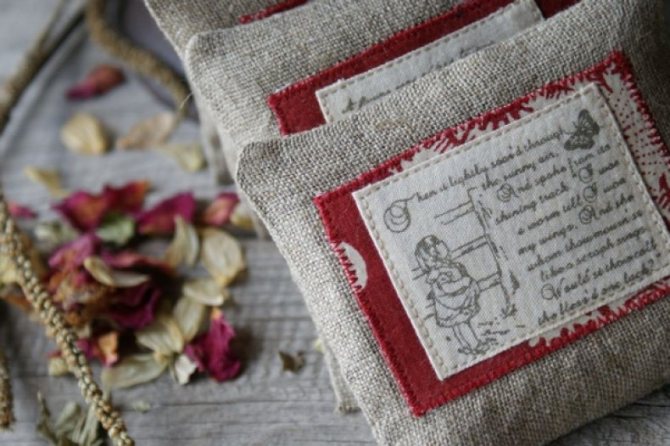

- such sachets are used depending on what flavor it carries. Lavender, for example, it is advisable to put where bedding is stored or a sleeping place is located.
It would be appropriate for a sachet with a pink scent to put on the shelf where clothes are stored, to carry it with you in your purse, because its aroma tones up, normalizes the psychological state, and is also a recognized aphrodisiac; you can dry the rosebuds and then use them as a scent for the room by placing them in a suitable container and dripping a few drops of the essential oil of this flower into it.
Such a composition will complement the interior and enrich the atmosphere of the house with an exquisite aroma. From time to time, the smell becomes less pronounced, then the container with the contents is shaken to "wake up";
- from dried flowers, you can create delightful compositions - panels or bouquets. The decor can be either neutral or, for example, congratulatory, or intended for a romantic evening - as fantasy prompts and the hands of someone who has managed to dry roses and create a composition from them will come to life;
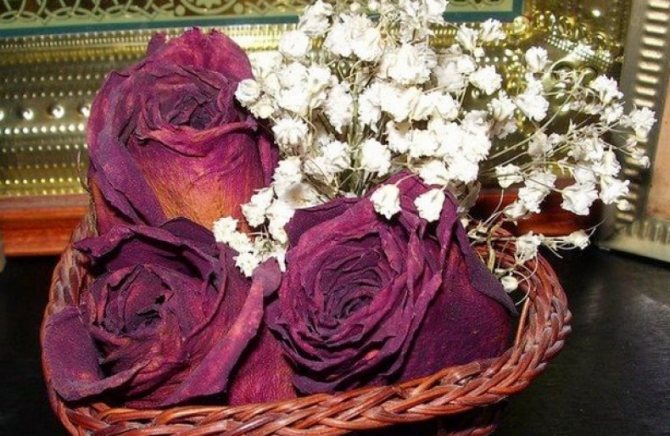

- romantic mood is difficult to imagine without roses, and especially their petals. They are used as confetti, added to ice for drinks, to bath water - in a word, wherever imagination dictates. A dried rose, threaded into a ring along with a linen napkin, looks interesting and elegant;
- a bath with rose petals and a few drops of rose oil will not only set you in a romantic mood - it will allow you to collect your thoughts, put them in order, relieve irritation and other negativity, calm the nervous system, help direct thoughts in the right direction;
- Nowadays, homemade soap has become a very popular hand-made industry.
Masters study the properties of various plants, substances and aromas, and of course, the rose has taken a well-deserved niche in this business, because thanks to its healing properties, it is used in cosmetology, and its aroma has a positive effect on the psyche.
Since fresh flowers suitable for soap making are not available all year round, they are successfully replaced by dried ones, collected ahead of time in ecologically clean places and harvested in accordance with technology.


Roses should be dried only in order to then prepare for themselves such a remedy as rose tea all year round, which:
- help to cope with irritability;
- will help with inflammatory processes in the mouth and in the gastrointestinal tract;
- improve the condition of nails, hair and skin;
- prolong youth;
- will increase the level of hemoglobin;
- has a beneficial effect on blood vessels and the thyroid gland;
- soothe and tune in the right way.
A dried rose looks very elegant in the design of a gift; it looks especially interesting if you attach a postcard or a homemade message to it.
Manufacturing instruction
To imitate the stem, wrap the wire tightly with tape. We pierce a ball into it, and the base of the topiary is ready. If you make a twisty branch like a spring, then the product will look more original.
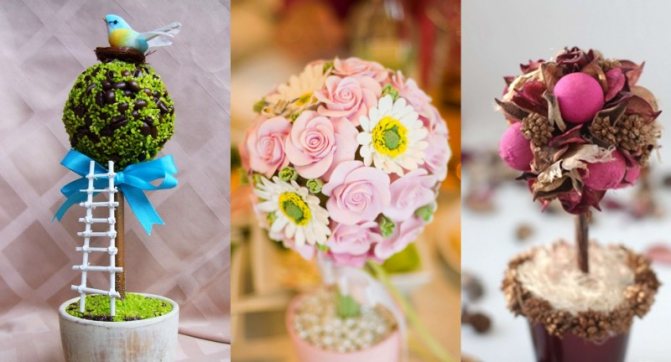

Then we make a crown. Glue the dried rosebud to the very top. We glue the next flowers only after we have made sure that the previous one holds well. Thus, we cover the whole ball with roses. If desired, the base of the stem can be decorated with dry leaves.


To "plant" a tree, pour the prepared alabaster solution into a pot and hold the trunk in it for 5-10 minutes. It is important to make sure that the tree is level.
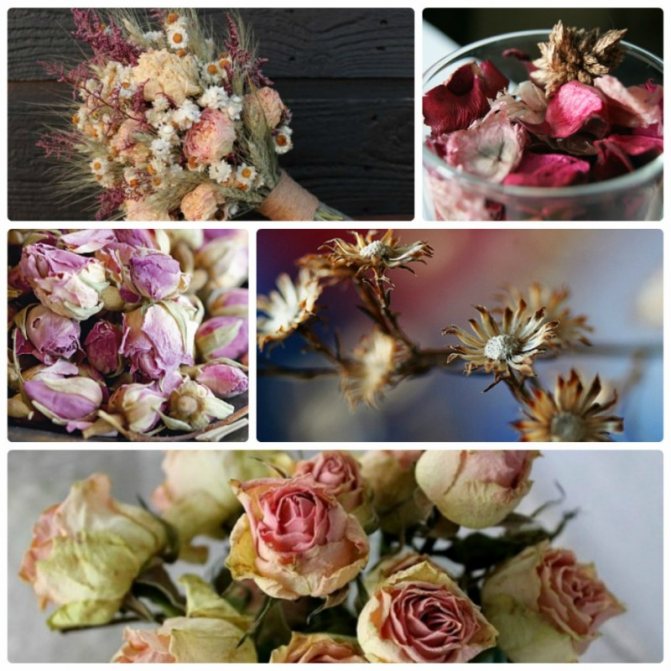

Until the solution is completely frozen, cover it on top with crushed petals and leaves and lightly press down. A wonderful craft of roses for home decor is ready.
